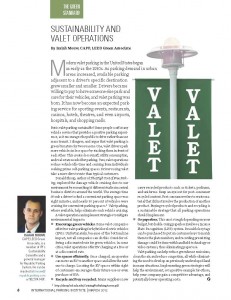 By Isaiah Mouw, CAPP, LEED Green Associate
By Isaiah Mouw, CAPP, LEED Green Associate
Modern valet parking in the United States began as early as the 1930s. As parking demand in urban areas increased, available parking adjacent to a driver’s specific destination grew smaller and smaller. Drivers became willing to pay to have someone else park and care for their vehicles, and valet parking was born. It has now become an expected parking service for sporting events, restaurants, casinos, hotels, theatres, and even airports, hospitals, and shopping malls.
But is valet parking sustainable? Some people scoff at any vehicle service that provides a positive parking experience, as it encourages the public to drive rather than use mass transit. I disagree, and argue that valet parking is green by nature for two reasons. One, valet drivers park more vehicles in less space by stacking them in front of each other. This creates less runoff, utility consumption, and real estate needed for parking. Two, valet operations reduce vehicle idle time and cruising from individuals seeking prime self-parking spaces. Drivers using valet take a more direct route than typical customers.
Donald Shoup, author of The High Cost of Free Parking, explored the damage vehicle cruising does to our environment by researching 16 different studies in central business districts around the world. The average time it took a driver to find a convenient parking space was eight minutes, and nearly 30 percent of vehicles were cruising for convenient parking spaces.1 Valet parking, where available, helps eliminate such vehicle cruising.
A valet operation can implement strategies to mitigate environmental impacts:
Encourage green vehicles. Some valet companies offer free valet parking for hybrid or electric vehicles (EVs). Unfortunately, because of the bottom line impact, not all companies can do this. Consider offering a discounted rate for green vehicles. In some cities, valet operations offer EV charging at a free or at a discounted rate.
Use spaces efficiently. Once charged, an operator can move an EV to another space and allow the next one to charge. Locating the EV spaces within sight of customers encourages their future use or even purchase of EVs.
Recycle and buy recycled. Many suppliers now carry recycled products such as tickets, podiums, and uniforms. Keep an eye out for post-consumer recycled content. Post-consumer refers to waste material that did not involve the production of another product. Buying recycled products and recycling is a sustainable strategy that all parking operations should implement.
Go paperless. This one is tough depending on your budget, but doable. Going paperless involves a License Plate Recognition (LPR) system. Reusable key tags can be purchased to put on customer keys to match them to the plate numbers, and recording preexisting damage could be done with handheld technology or video systems, thus eliminating paper use.
Valet parking can help reduce greenhouse emissions, clean the air, and reduce congestion, all while eliminating the need to develop on previously undeveloped land in many situations. Implementing green strategies will help the environment, set a positive example for others, help your company gain a competitive advantage, and potentially lower operating costs.
Isaiah Mouw, CAPP, LEED Green Associate, is a member of IPI’s Sustainability Committe and a general manager for Republic Parking System. He can be reached at imouw@republicparking.com or 502.574.1497.
TPP-2012-03-Sustainability and Valet Operations
